Lecture 3a, Optical Illusions
Simply stated, an optical illusion is some graphic image where
the vast majority of people misinterpret the image.
Sample 1.
Are the squares with the letters A and B the same shade of gray?
 Next, pan down to another shot of purportedly the same scene
where the squares with the letters A and B have been
connected with a strip that is the same color as both
squares.
In this image, do the squares with the letters A and B have
the same shade of gray?
Next, pan down to another shot of purportedly the same scene
where the squares with the letters A and B have been
connected with a strip that is the same color as both
squares.
In this image, do the squares with the letters A and B have
the same shade of gray?
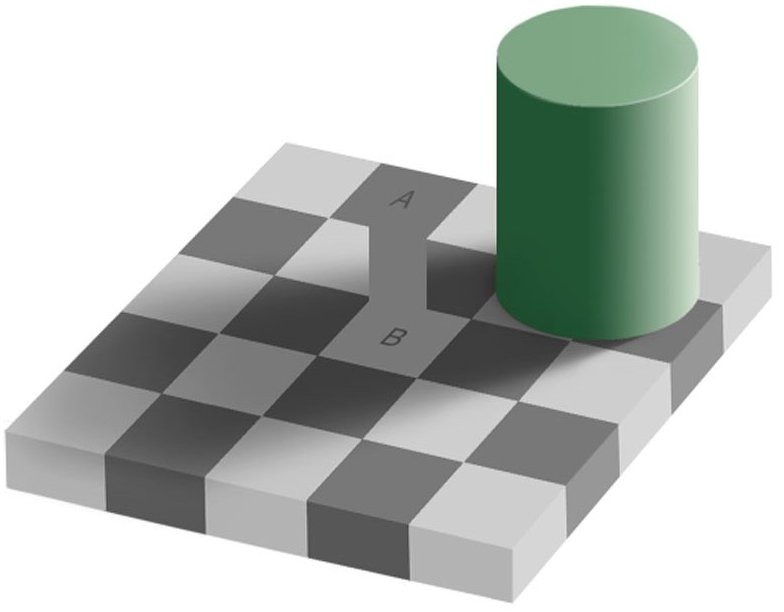 To determine actual color as opposed to perceived color,
we can sample individual pixels of each square.
We now find the shades of gray very close together.
Each color R red, G green, and B blue can have
an intensity from 0 = black = no color, to 255 maximum color.
Gray RGB goes from 0 0 0 black to 255 255 255 white.
R=G=B in gray. All numbers below are RGB values.
In the illusion image I measured pixels in A
from 117 117 117 to 121 121 121
In the illusion image I measured pixels in B
from 119 119 119 to 130 130 130
In the connected image I measured pixels in A
from 113 113 113 to 120 120 120
In the connected image I measured pixels in B
from 120 120 120 to 127 127 127
The mean of the histogram for A was a few less
than the mean of the histogram for B in both images.
The original images are from http://apod.nasa.gov/apod/ap091004.html
Is this rotating? Stare at it.
To determine actual color as opposed to perceived color,
we can sample individual pixels of each square.
We now find the shades of gray very close together.
Each color R red, G green, and B blue can have
an intensity from 0 = black = no color, to 255 maximum color.
Gray RGB goes from 0 0 0 black to 255 255 255 white.
R=G=B in gray. All numbers below are RGB values.
In the illusion image I measured pixels in A
from 117 117 117 to 121 121 121
In the illusion image I measured pixels in B
from 119 119 119 to 130 130 130
In the connected image I measured pixels in A
from 113 113 113 to 120 120 120
In the connected image I measured pixels in B
from 120 120 120 to 127 127 127
The mean of the histogram for A was a few less
than the mean of the histogram for B in both images.
The original images are from http://apod.nasa.gov/apod/ap091004.html
Is this rotating? Stare at it.
 It is all down hill on these stairs.
It is all down hill on these stairs.
 Try to build this triangle.
Try to build this triangle.
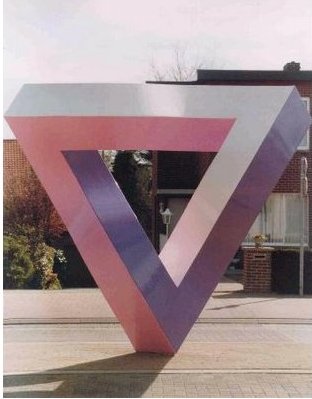 Are the lines parallel?
Are the lines parallel?
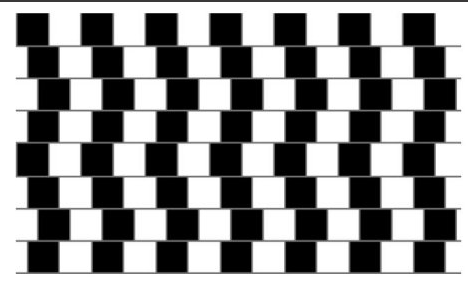 Are the orange circles the same size?
Are the orange circles the same size?
 Do you see color shading in 4 shapes?
Do you see color shading in 4 shapes?
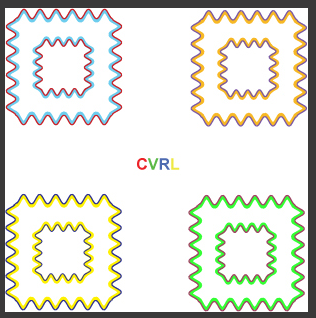 There is no white triangle.
There is no white triangle.
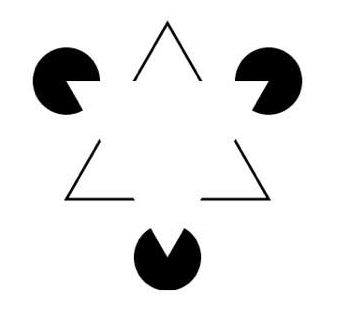 Do you see a banister or people?
Do you see a banister or people?
 Do you trust your eyes?
Well, it is really your brain making mistakes.
Do you trust your eyes?
Well, it is really your brain making mistakes.
<- previous index next ->
Many web sites on Java GUI, AWT, Swing, etc.
Many web sites on Python wx, tk, qt, etc.
Next, pan down to another shot of purportedly the same scene where the squares with the letters A and B have been connected with a strip that is the same color as both squares. In this image, do the squares with the letters A and B have the same shade of gray?
To determine actual color as opposed to perceived color, we can sample individual pixels of each square. We now find the shades of gray very close together. Each color R red, G green, and B blue can have an intensity from 0 = black = no color, to 255 maximum color. Gray RGB goes from 0 0 0 black to 255 255 255 white. R=G=B in gray. All numbers below are RGB values. In the illusion image I measured pixels in A from 117 117 117 to 121 121 121 In the illusion image I measured pixels in B from 119 119 119 to 130 130 130 In the connected image I measured pixels in A from 113 113 113 to 120 120 120 In the connected image I measured pixels in B from 120 120 120 to 127 127 127 The mean of the histogram for A was a few less than the mean of the histogram for B in both images. The original images are from http://apod.nasa.gov/apod/ap091004.html Is this rotating? Stare at it.
It is all down hill on these stairs.
Try to build this triangle.
Are the lines parallel?
Are the orange circles the same size?
Do you see color shading in 4 shapes?
There is no white triangle.
Do you see a banister or people?
Do you trust your eyes? Well, it is really your brain making mistakes.